September 2012 Newsletter
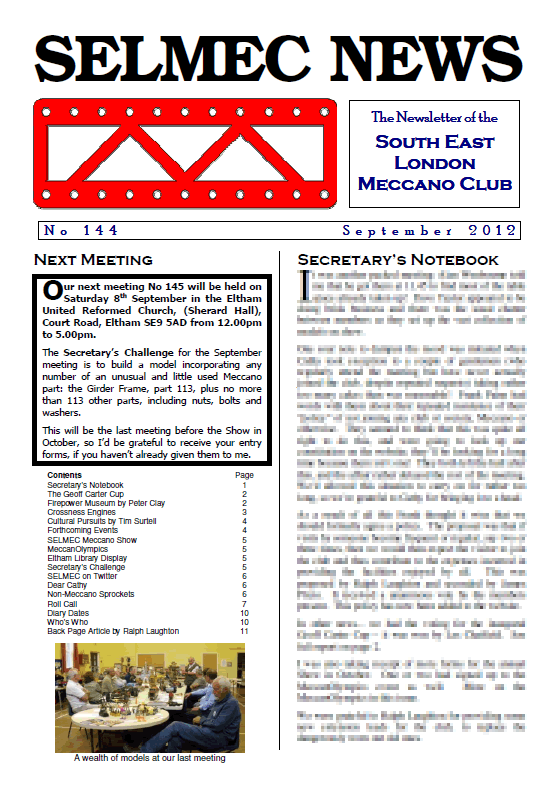
September 2012 Newsletter
Issue 144
This was one of our informal quarterly meetings where our members showed off their latest Meccano creations.
At around 2:00pm we had a short committee meeting, followed by the Model Tour in which members were invited to give a short talk about their models — in particular their entries for the Secretary’s Challenge!
Report written by Peter Clay
On the weekend of 2nd–3rd June a few SELMEC members, at the invitation of Paul Plummer of the Erith Model Railway Society, joined them for their annual model railway exhibition at Firepower, the Royal Artillery Museum in Woolwich. We were placed on the first floor overlooking much of the museum. Like many such displays, ‘punters’ got the run of the museum, the model railways and the Meccano. Those exhibiting were, on Saturday:
Adrian Ashford showed a fireless steam locomotive (appropriately) powered by clockwork running faultlessly up and down its length of track. He also showed a skimmer excavator, from Meccano Magazine, powered by electric motor performing to spectators.
Brian Elvidge brought a large steam power plant in yellow and zinc, running from an electric motor. He also had a gun carrier (appropriately again) from Army Multikit parts with plastic track powered by 6-speed PDU.
Tim Surtell displayed his Lightning Leap game, in which spectators had to run a ring along a zigzag track without touching the latter — or flames would come up from the end towers! A well-designed model popular with young and old. He also had his version of Konkoly’s Spanish Knight, sitting astride a horse with proudly trotting legs and waving tail on a rotating base, with a black horse and much more compact stand than the original.
Peter Clay brought his Ultrasupervariograph Meccanograph making designs many of which were taken by young spectators. He also showed a differential demo mechanism and several small models.
Adrian and Peter ‘held the fort’ on the Sunday.
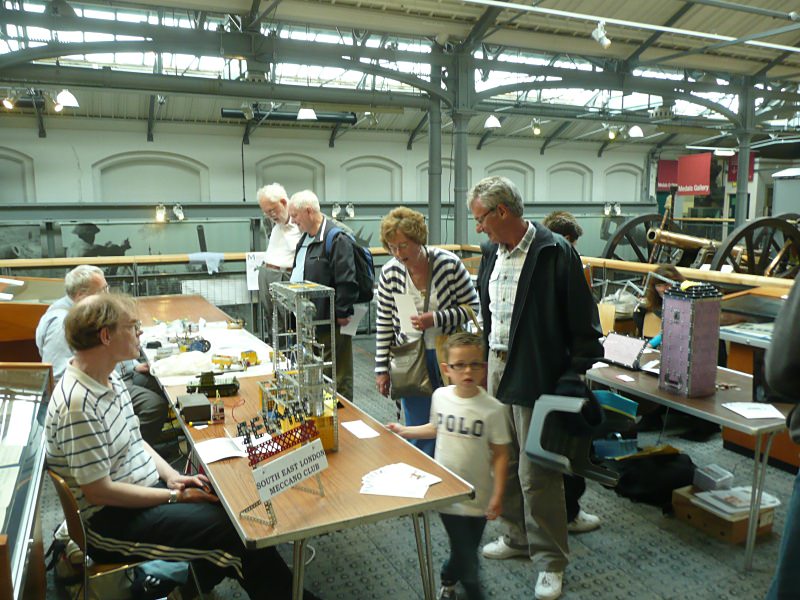
Our stand on the balcony at the Firepower Museum
The whole exhibition was well organised with free lunches and drinks for participants. What I was able to look at of the railway exhibition was impressive with many different gauges and types of model, including a large, detailed layout with working trains made entirely in Lego! Among the museum’s own exhibits — which as the title implies consists mainly of guns and weaponry — is a model of what must be the prototype of the last Meccano Supermodel; the caterpillar artillery tractor.
Both days were fairly quiet — Sunday in particular, due to the Queen’s Golden Jubilee celebrations. Maybe the horrific rain on Saturday night also put people off. Nevertheless those that came showed an interest and many took away exhibition flyers. Chris and Cathy, Doug Windibank and Jim Arthur came to give their support. All in all, an enjoyable event, a good follow-up to last year and a good chance to fly the flag for our hobby and our club.
Report written by Chris Warrell
SELMEC is constantly making quite a name for itself; an impressed (or possibly impressionable) man from the Crossness Engines Trust saw our Meccano Show last year and thought we’d be perfect for one of their steaming days. Sunday 24th June (the day after our summer meeting, so that’s dedication for you!) saw ten of us turn up to their Model Engineering themed event.
Unlike at Kew Bridge Steam Museum, this museum is open only on about half a dozen specific days throughout the year, so you can’t just turn up on the off-chance that they’re open. It’s at the back of beyond as well, being on the banks of the Thames, hidden behind the sprawling Thamesmead town. Luckily it’s well signposted from the immediate surrounding area, but there’s no regular bus service. (They do run a shuttle bus to and from Abbey Wood station on these days during the hours open to the public. Not much use if you have to arrive before the public though.)
Tim Surtell, his mum Felicity and I arrived with Ralph and Sue Laughton (in both their car and the Transit!) about the same time as Brian Elvidge and Douglas Windibank so there were plenty of us to sort out the tables into an island, with us in the middle, rather than the reverse way that the tables had been laid out. My initial request for six tables was increased to nine a few days beforehand, and we had no trouble filling them with our customary wide selection of models.
We, along with the Erith Model Railway Society, some live steam models, and the Falconwood Transport and Military Bookshop, were located in the Boiler Room. I seem to remember that this was a cramped area with a grotty broken concrete floor. Not any more: it’s now very light and airy with a light grey painted floor, a new toilet block and stairs down to a new cafe which was serving a wide range of refreshments.
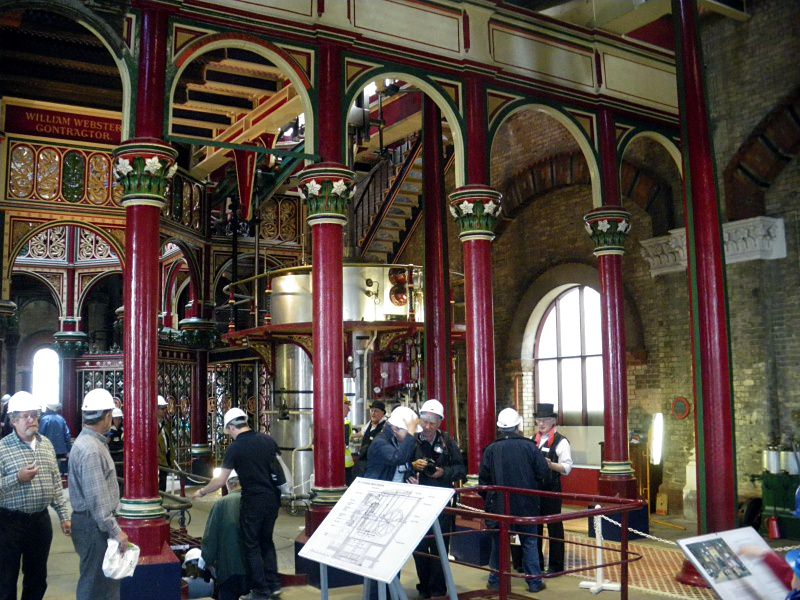
Beam engine house
The Crossness Pumping Station was built by Sir Joseph Bazalgette as part of Victorian London’s main sewerage system. It was officially opened by the Prince of Wales in April 1865.
The Boiler House led to the Grade 1 listed Beam Engine House. It is certainly the star of the show, no matter what complex Meccano models we can try and build. It is an almost cathedral-like structure built in the Romanesque style and features some spectacular ornamental Victorian cast ironwork, with various details, such as fruit and leaves, being picked out in different colours. It also contains the four original pumping engines (although the cylinders were upgraded in 1901), which are possibly the largest remaining rotative beam engines in the world, with 52 ton flywheels and 47 ton beams.
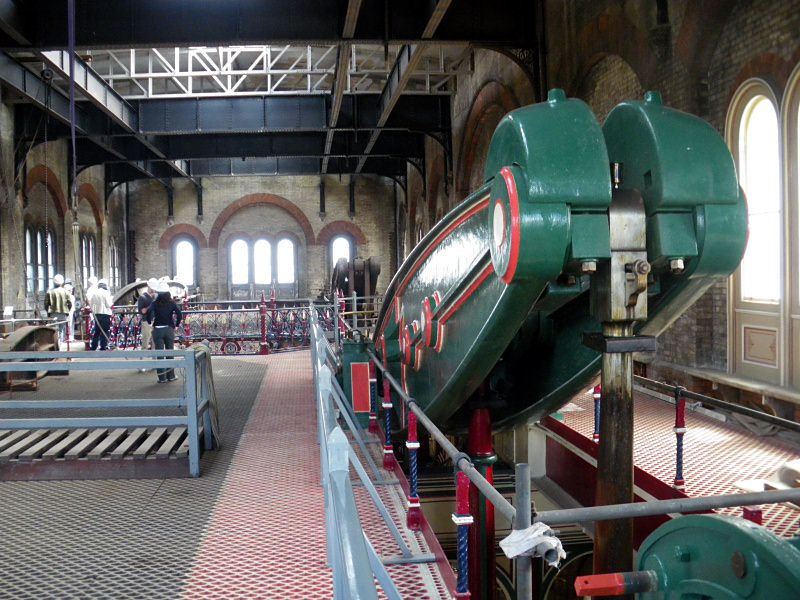
Main beam floor
The Crossness Engines Trust, a registered charity which was set up in 1987, has been restoring the installation. So far, all the restoration work has been done entirely by unpaid volunteers.
There was a good flow of visitors past out stand, and everyone agreed what a fantastic day it was. All being well, we’ll be invited back next year.
Members attending the event were as follows:
Jim Arthur — Barring engine; 105mm gun and Ferris wheel.
Adrian Ashford — Roundabout.
Cathy Claydon — Bren gun carrier; 25 pound field gun and VW Beetle.
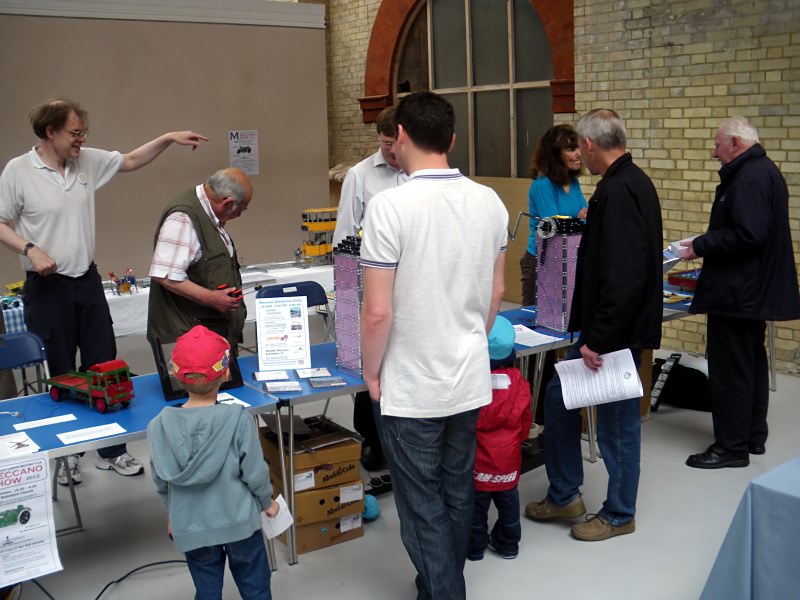
Brian Elvidge points visitors in the right direction
Brian Elvidge — Watt’s beam engine and Temsi transport lorry.
John Gay — Leyland fire engine and steam road loco.
Ralph and Sue Laughton — Pre-war clock; old Meccano loom and 1970s dealer’s display windmill.
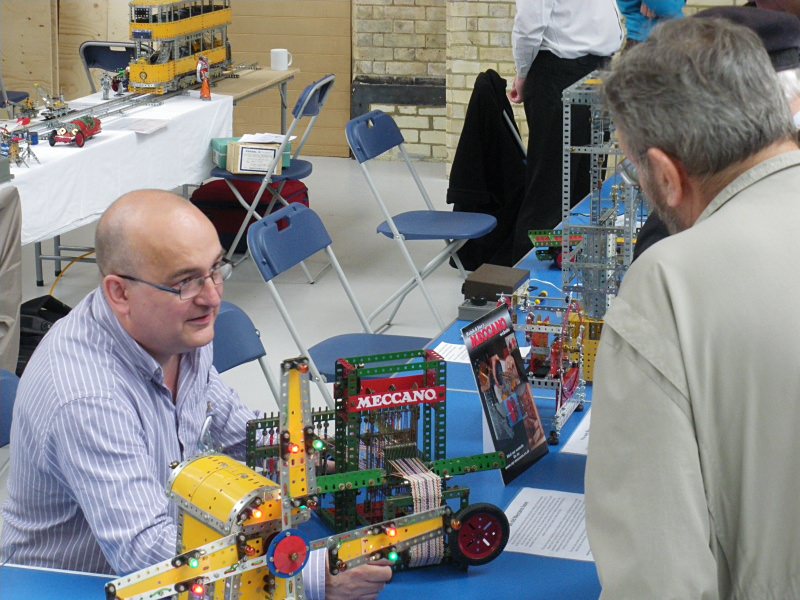
Ralph Laughton shows off his new loom
Tim Surtell — The Lightning Leap game; The Spanish Knight; Van Gogh’s ‘Sunflowers’ and Olympic swimming pool.
Chris Warrell — HR1 tramcar; Three-wheeled car; Bugatti car; bus shelter; small robots; two small railway breakdown cranes and drum kit.
Douglas Windibank — Troop carrier; field gun and limber; tank; robot and nano robot; Harley Davidson motorcycle; three Space Chaos models; Tin Tin seaplane; bi-plane; Sopwith Camel; Red Arrow; glider; turbo race car and go kart; pull back and go drag racer and a vintage lorry.
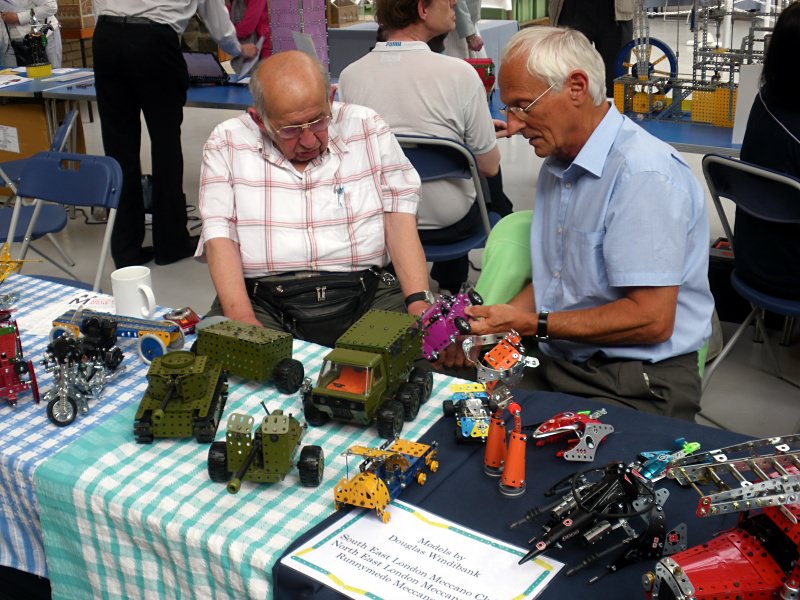
Douglas Windibank and John Gay wonder if the purple VW Beetle matches the green of the army vehicles
Report written by Tim Surtell
Over the weekend of 14th–15th July 2012 the club was invited to take part in the ‘Cultural Pursuits’ event organised by artist Ruth Beale. The purpose of the occasion was to introduce local people to the wealth of independent clubs and associations operating in the Eltham area.
The free weekend workshops were held as part of a Summer School at the Gerald Moore Gallery. This is a new space at Eltham College which opened in April, given over to modern and contemporary art.
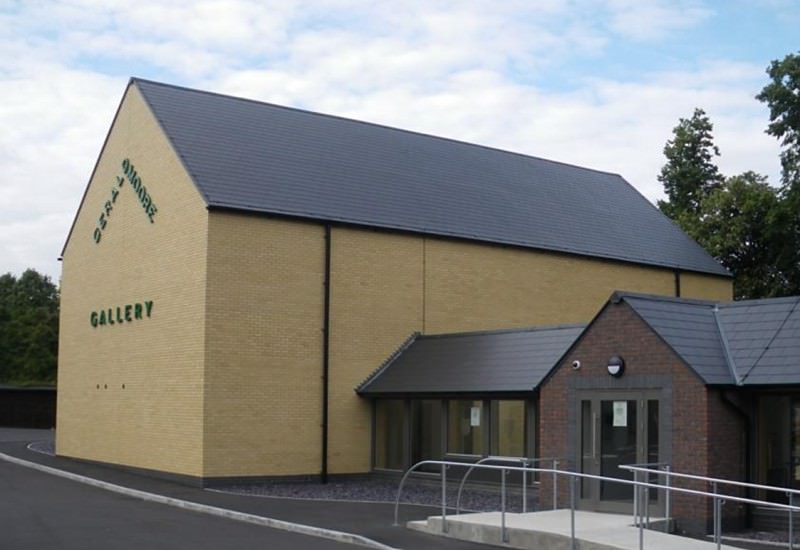
The Gerald Moore Gallery
Each day we were joined by many other clubs covering subjects such as photography, lace making, philosophy and history, and were treated to tea, coffee and lovely home-made cakes courtesy of the South East London Clandestine Cake Club.
Several clubs took the opportunity to give talks and demonstrations in the gallery or the adjacent lecture space. We watched performances by the Lewisham Banjo, Mandolin and Guitar Club, the bell-ringers from St John the Baptist Church in Eltham (with their hand bells!) and had a go at using a radio antenna to find a transmitter hidden by Bromley and District Amateur Radio Society up a tree in the grounds.
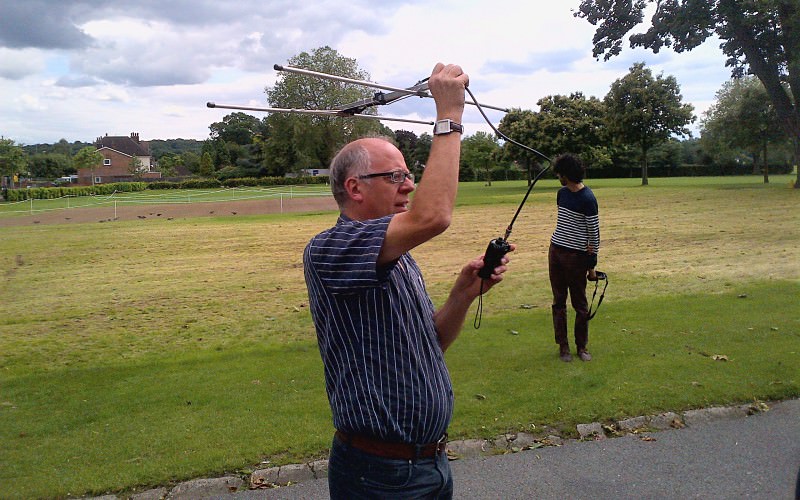
Chris Warrell attempts to lead us to the hidden transmitter
On Saturday Alan Wenbourne gave a talk on behalf of the club, describing the process involved in developing his model of Thomas Heatherwick’s Rolling Bridge and also giving a slide show of some of his other models such as the London Eye. Naturally, Alan had brought the model along for all to view after the talk.
Peter Clay showed one of his Meccanographs and supplied visitors with designs to take home.
Tim Surtell had his Lightning Leap buzz-wire game, the Spanish Knight designed originally by Andreas Konkoly, and two other models quite appropriate to the venue; Van Gogh’s Sunflowers and an Olympic swimming pool (Eltham College is an official Olympic training centre).
Chris Warrell displayed a large selection of models including a snowplough, railway breakdown cranes, two small cars and the Olympic torch. He also had a ‘hands-on’ table for people to try out some Meccano model building.
All in all, the weekend was quite a refreshing change from the hustle and bustle of the exhibitions and events we usually attend and a great opportunity to meet other local clubs and societies.
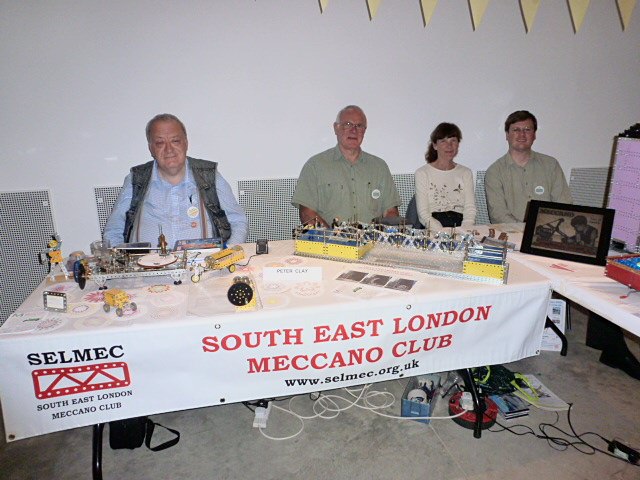
Peter Clay, Alan Wenbourne, Felicity Surtell and Tim Surtell at our stand
Written by Cathy Warrell
John Gay has been inspired by my article on Meccano Repairs in the March 2012 newsletter and sent me this letter about his own experience:
“Just this week the rubber seal on the metal bath plug perished, so the bath water was running away. So it was Meccano to the rescue — the old perished rubber seal was replaced by a Meccano drive band (part № 186) and it works well.”
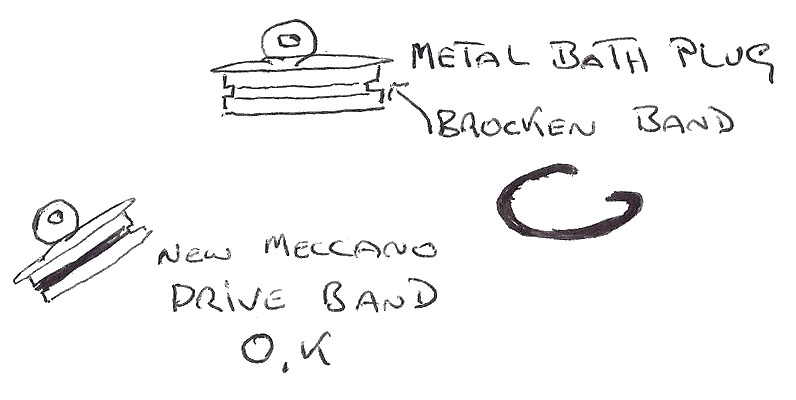
John’s seal solution
Thanks for your letter, John. It sounds great! I didn’t know you could get metal bath plugs — ours are all rubber! Actually, I’m not the best person to be talking about Meccano at all, since I find it very hard to bolt any of it together at all. The last time I tried I felt I could do with at least two extra hands! I think I’ll hand my Meccano Repairs column over to Chris and have a Cathy’s Cakes column instead!
Les Chatfield has also been keen to share with us his experience with Meccano repairs:
“I made a ‘repair’ to a (non Meccano) model of Hastings East Hill lift. The original drive was home made and I replaced it with this gearbox assembly that utilises plastic gears as silent running was essential.
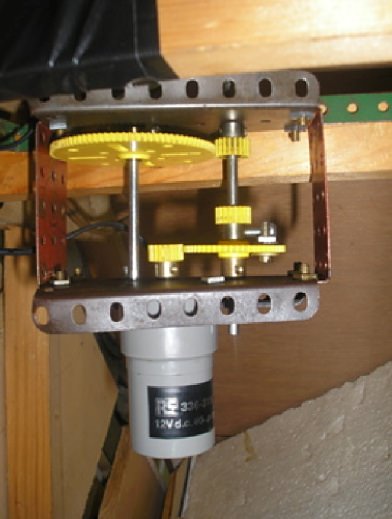
Les’s gearbox
Of interest is the long bolt fitted through a hole in the plastic gear wheel driven by the non-Meccano motor. The drive to this motor was reversed by the cars of the model hill lift itself operating limit switches wired through to a clever DPDT relay made from an old H & M point motor.
The long bolt driven by the gear wheel has to rotate a complete revolution before encountering another long bolt securing the small plastic pinion to the shaft. Both gearwheel and shaft would then revolve together driving the rest of the gear train and the winch operating the hill lift.
This simple device gave the cars a brief ‘wait’ at each and of their journeys before starting off again.
The Hill lift model itself may be seen at the Brighton Toy and Model Museum (where I used to work as ‘Train Doctor’).”
Written by Michelle O’Brien
Standard Meccano chain and sprocket drives have a nasty habit of jumping a link or two now and again, or so I’ve found. If you can’t/don’t get the positioning of the two sprockets quite right, especially where one is above the other (rather than them being aligned side by side), and if/or the chain linking them is a shade too slack — instead of a nice smooth drive you sometimes get a series of jerks as the chain links jump the sprocket wheel teeth. It mostly happens under heavier loads.
MFA/Como Drills have a range of timing pulleys and belts which can overcome this problem for situations where smoothness and precision of drive transmission are essential — for example, if you’re driving something using a stepper motor that needs exact positioning with no slippage. The pulleys are Meccano-compatible with grub-screw fastened hubs that fit snugly on standard 4mm Meccano axles. They come in a variety of sizes from 16 to 44 teeth and the driving belts for them range in circumference from 165mm to 840mm.
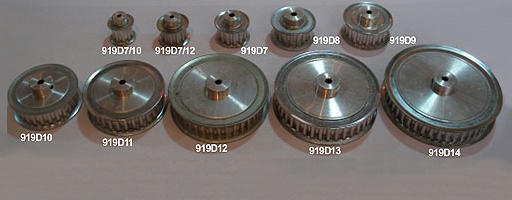
MFA/Como Drills timing pulleys
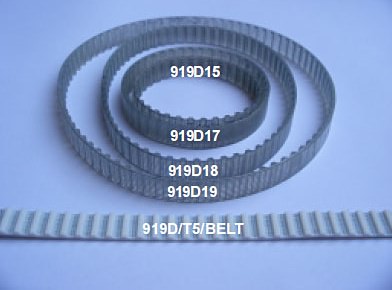
MFA/Como Drills timing belts
The price you pay for absolutely positive transmission is that the pulleys are a bit ‘chunky’ by Meccano standards, which can be a difficulty where space is tight. But of necessity they have to be a fair bit wider than ‘slim-line’ Meccano sprocket wheels in order to accommodate the 9.8mm width of the timing belts that ensure the no-slip drive precision.
For full details of the range go to www.mfacomodrills.com/timing_belts_timing_pulleys/timing.html
Report written by Ralph Laughton
Now before you correct me, I know the event is advertised as a three day event but the Thursday, which is really setting up day, has turned into one of the most important days to be there as this is when the dealers bargains are to be had. It is also a good opportunity to catch up with other modellers from around the country and indeed from around the world.
The show, fondly known as SkegEx in the Meccano world, does not have the largest public attendance at around a thousand visitors over three days (Meccanuity 2012, held at Enginuity in Coalbrookedale, had over 2,300 visitors this year). It seems to attract modellers from around the globe and this year was no exception. There was a strong contingent from South Africa, this year, as well as modellers from Europe and as far away as New Zealand. Trade support is very good with both Dave Taylor and Mike Rhoades displaying vast amounts of stock usually unseen anywhere else. Several other traders were present including Ian and Mark Wilson from Northern Ireland with stocks of his superb reproduction Meccano parts. Ian’s standard of workmanship is far better than a lot of the Meccano originals. He makes some special parts like caterpillar tracks and small hub discs. As this was not our first year attending the show we know what to expect and managed to moderate our spending. However, I know for a fact that the temptation of all those Meccano parts was too much for at least one SELMEC member!
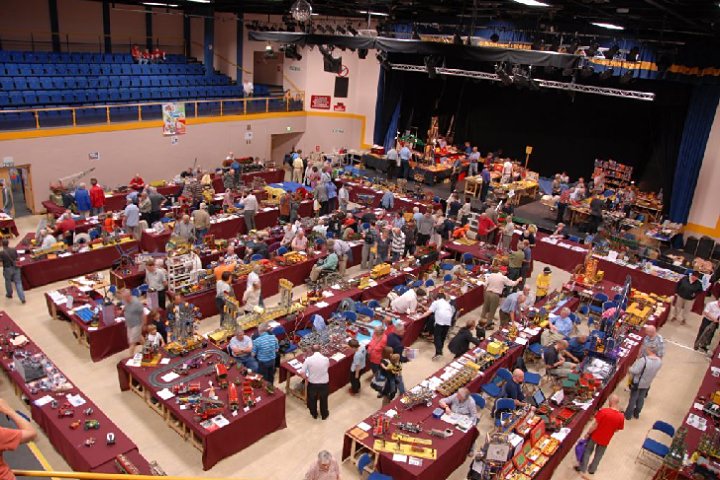
An overview of the Show floor from the balcony
For Sue and I SkegEx is far more than just a three (or four!) day Meccano show. There is plenty to do in the evenings, as there are lots of restaurants and bars to frequent. We (SkegEx exhibitors) also have an open invite to the New Park Club where on the Friday night the North Midlands Meccano Guild committee and organisers of the show put on a super buffet for exhibitors at the show. The best bit is the price of the drinks — you usually get change from a single note!
The show officially kicks off on Friday and the public start to arrive. This year we took our model of a handloom that we restored back to life after sitting around in a loft for the best part of thirty years. Originally built by the late Bill Roberts, it got us looking into looms a bit further and as a consequence we were showing our part built Super Model 16a loom and the enormous beaming frame. It is just amazing how much interest looms at a show create; especially when the viewer realises they actually work!
This year there was not one model that overshadowed the show. The guys from France, who usually attend with an enormous model, went to Meccanuity in May this year and I suppose decided to give SkegEx a miss. We felt that this was a refreshing change as the model selection was much wider and there were a lot of smaller models. There were a couple of big cranes; Richard Payne was showing his Takraf Level Luffing Crane built from immaculate late Binns Road dark blue Meccano with a selection of modern light grey flexible plates. Last year’s Issigonis shield winner John Ozyer-kay was showing his version of the Eric Taylor level Luffing Crane with its sophisticated radio control. Many other cranes in various shapes and sizes were in evidence too. But for us, it was the variety of models on show that was striking. Clocks of all shapes and sizes, ball rollers and trucks, bridges and locomotives: it was all there to see.
The SELMEC contingent was there in force this year. Most of the usual rabble of good old South Londoner’s venturing north, model under their arm and not a knotted handkerchief in sight!
This year the Issigonis Shield was awarded to Michael Whiting for his very unusual model of Noah’s Ark complete with animals two-by-two. It does make a change for something other than a mechanical-heavy model to win this prestigious award. There were a few mutterings around the hall and subsequently on the web regarding this result but at the end of the day the award is given based on votes from other exhibitors — a very worthy winner in my book!
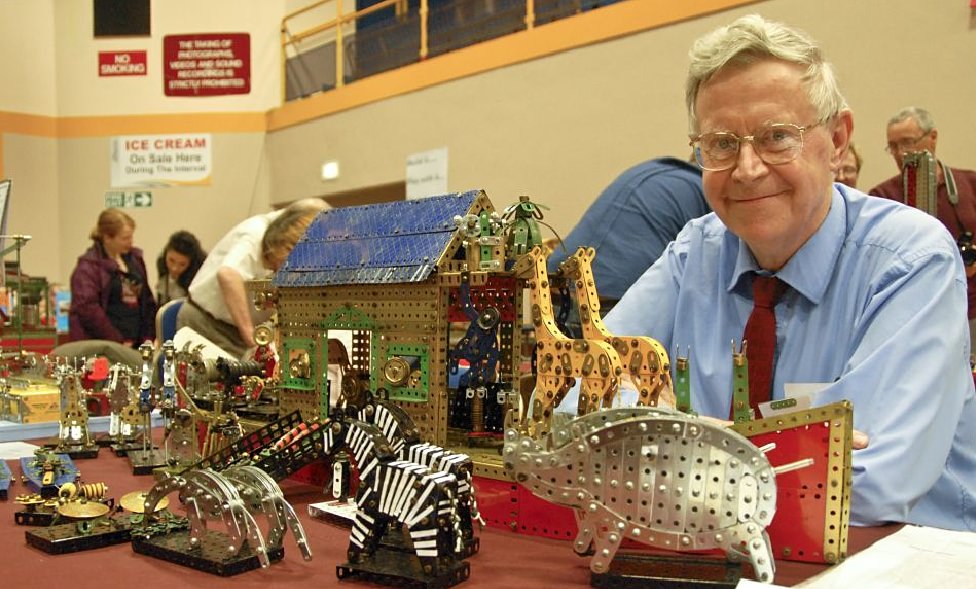
Michael Whiting with his Issigonis Shield-winning model of Noah’s Ark
Other models that caught our eye included the Scammell push–pull combination; a joint effort between Richard Payne and John Hornsby.
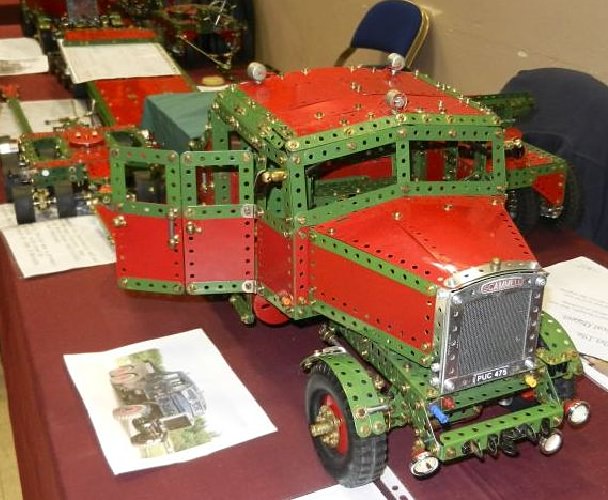
Richard Payne and John Hornsby’s model Scammell
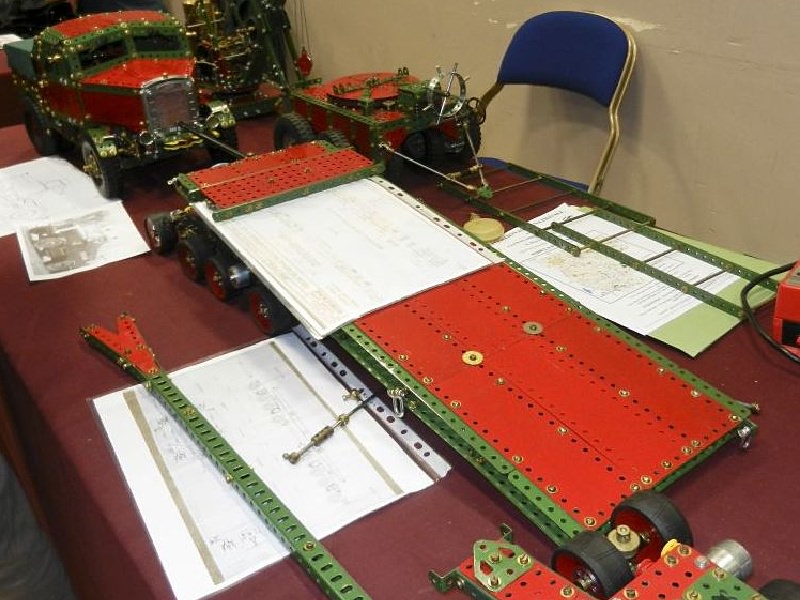
Richard Payne and John Hornsby’s model Scammell
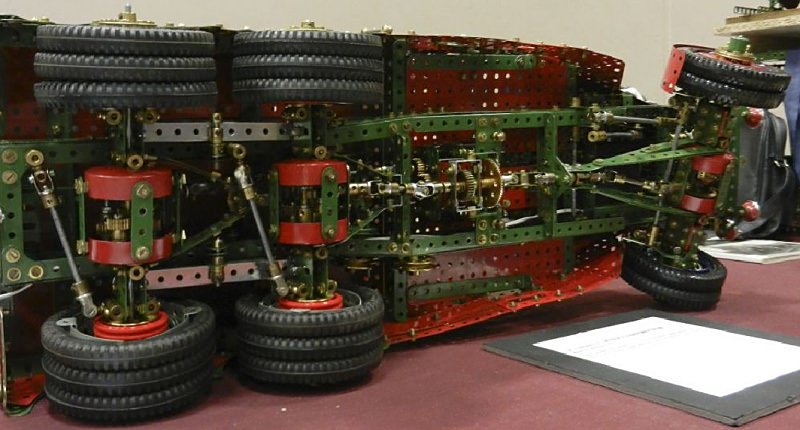
Richard Payne and John Hornsby’s model Scammell
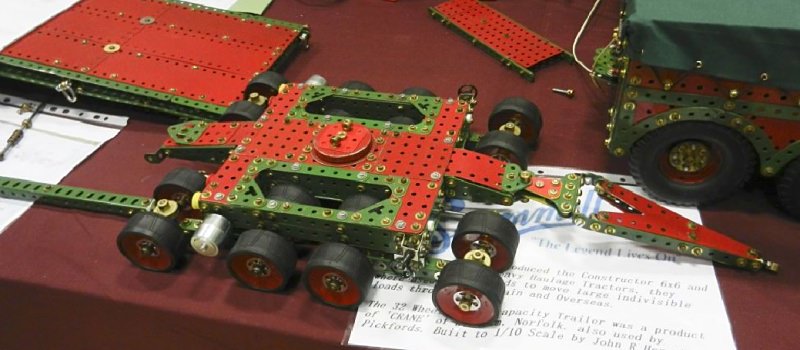
Richard Payne and John Hornsby’s model Scammell
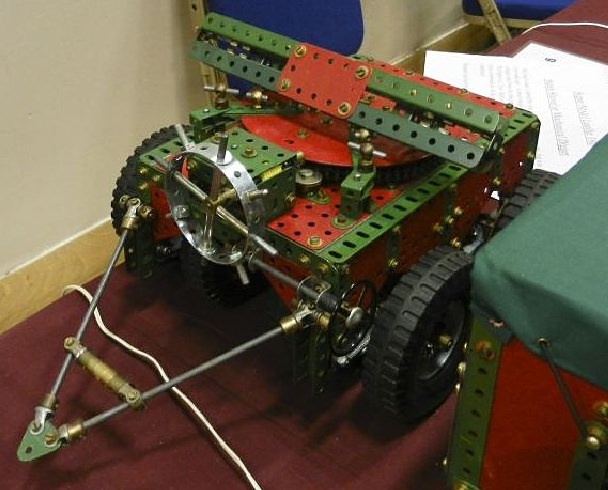
Richard Payne and John Hornsby’s model Scammell
SELMEC’s Cathy Claydon exhibited her superb model of a WWII Austin K2 ambulance built mostly from Meccano Army Multi-kit parts. This was one of my favourite models of the show.
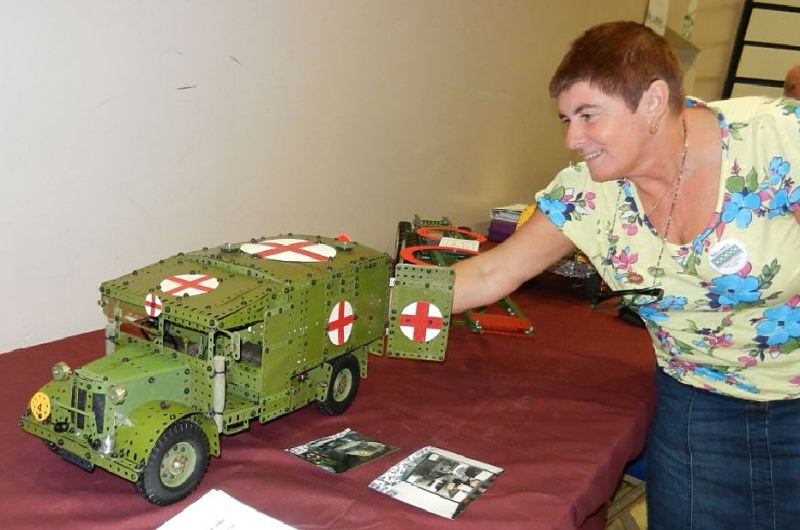
Cathy Claydon’s model of a WWII Austin K2 ambulance
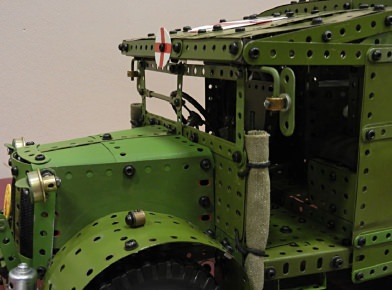
Cab detail
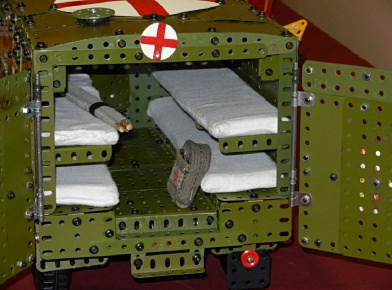
Interior detail
Another good reason for attending SkegEx is that you will get to see models that are not seen down here in the South East. One such model is Joe Etheridge’s huge model of Newport Bridge, Middlesbrough as featured on the front cover of the April 1935 edition of Meccano Magazine.
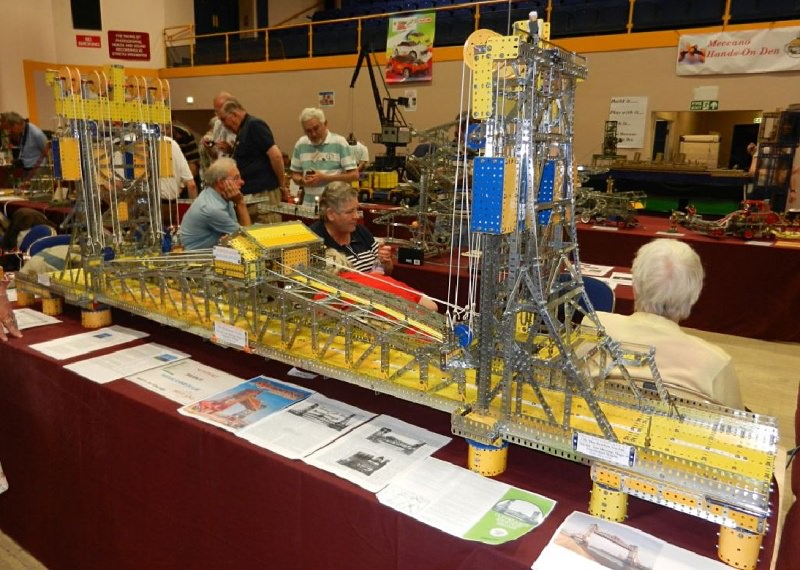
Joe Etheridge’s model of Newport Bridge
Terry Allen’s 1925 Brough Superior SS100 was an example of just what can be achieved with careful modelling and attention to detail.
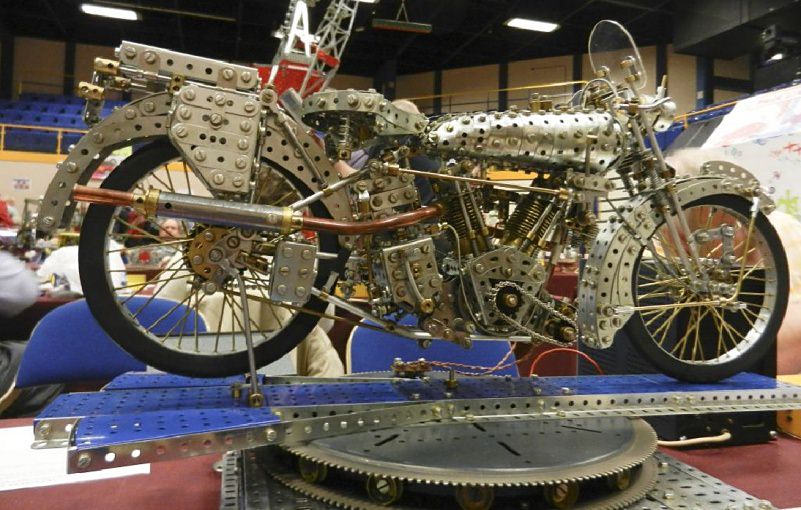
Terry Allen’s 1925 Brough Superior SS100
Roelf Valkema from Holland is a regular visitor to SkegEx and this year brought along a Meccano classic ‘The Meccano Limousine’ built from nickel finish Meccano, the model is based on the 1923 ‘New’ Meccano chassis.
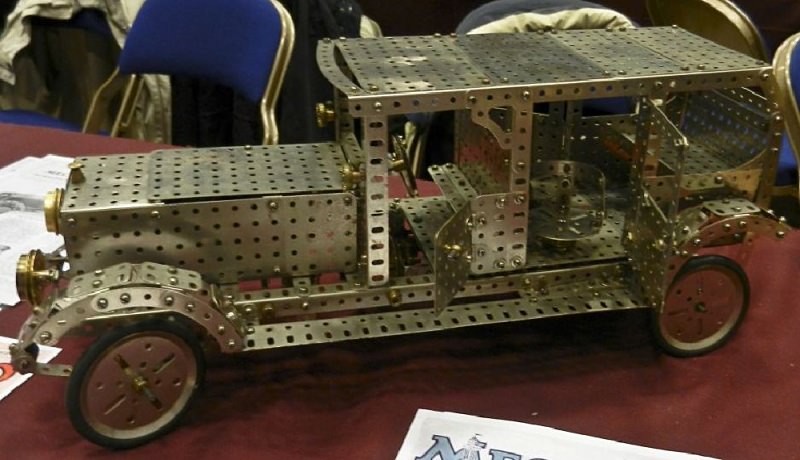
‘The Meccano Limousine’ by Roelf Valkema
Finally I just had to show you these two fine models by French modeller Jacques Vuye. He has built several miniature versions of the super models and I have included a couple here; the Steam Excavator and the Pontoon Crane.
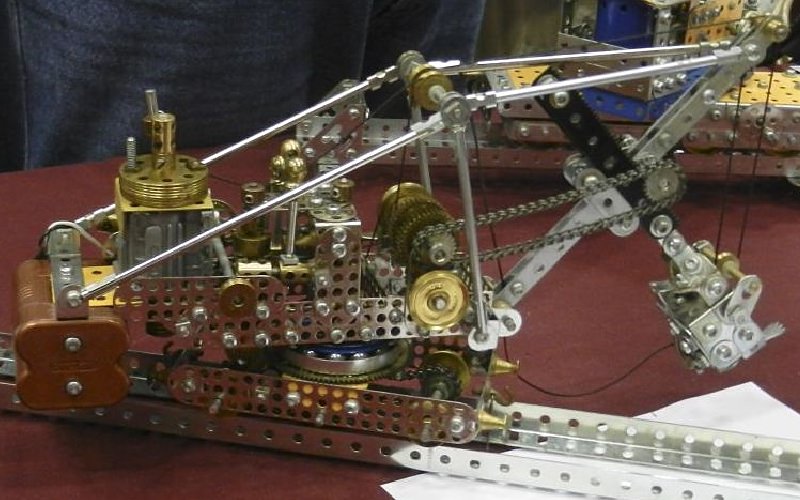
Jacques Vuye’s Steam Excavator
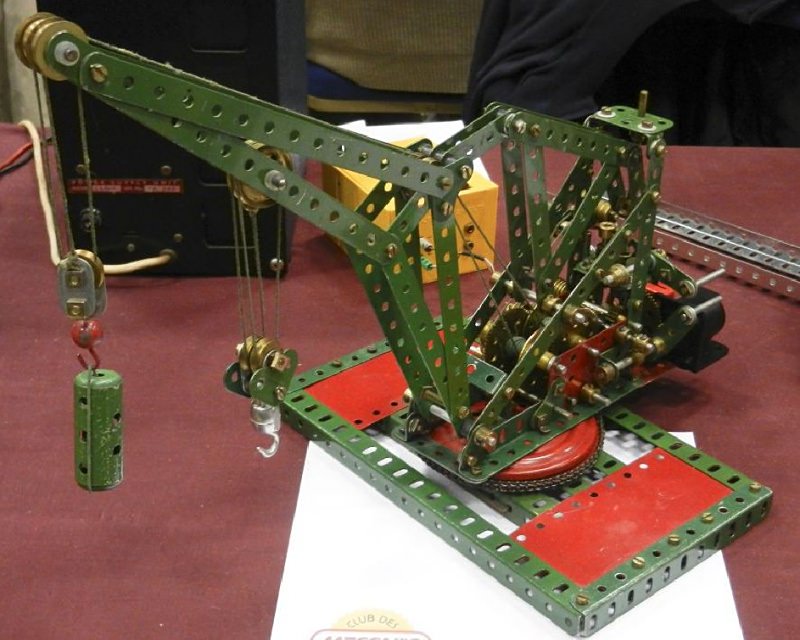
Jacques Vuye’s Pontoon Crane
There were many more models to see and discuss but I hope this small selection of our favourite models will give those of you who were not able to attend a flavour of the weekend.